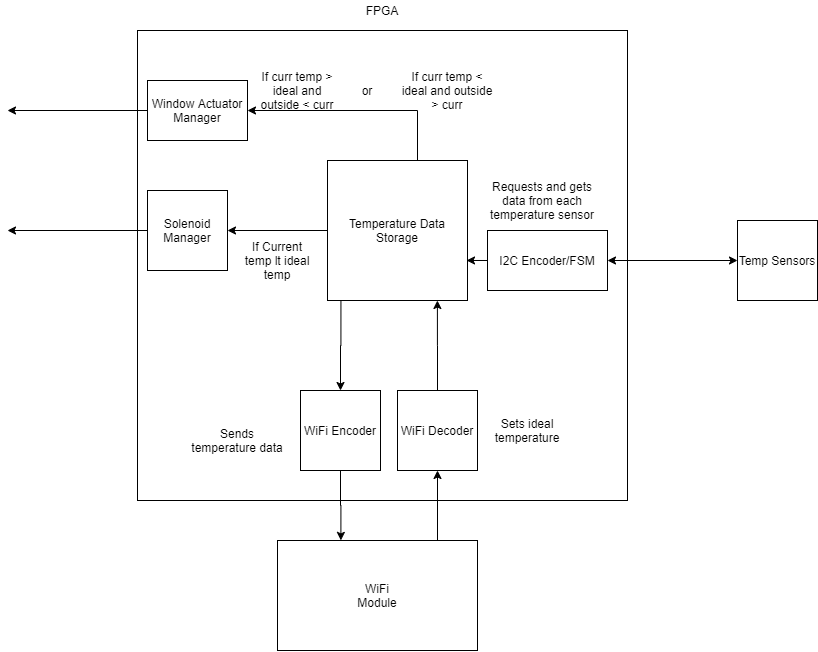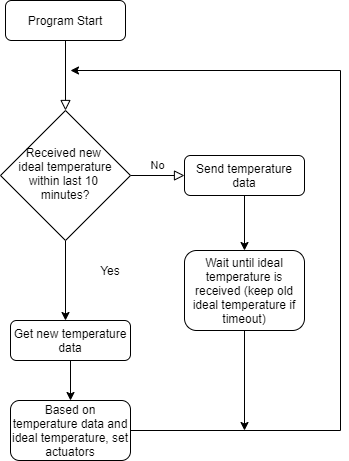As we move forward into a post-climate-change future, temperature regulation proves to be increasingly important for human survival and comfort, which makes up a significant portion of a building’s energy consumption. As such, our project focuses on improving the energy efficiency of temperature regulation in buildings through the use of Traditional Ecological Knowledge and smart-home design (with the help of the Azure cloud).
Ventilation, cooling, and heating account for 33% of energy use in U.S. commercial buildings, which relies upon conventional systems of cooling down air via refrigerants and pushing the air into rooms. However, there are different methods of cooling that utilize more passive properties of airflow. The Eastgate Centre in Zimbabwe is the biggest example of this.
The Eastgate Centre was designed with biomimicry in mind, to emulate the ability of termites to cool down and ventilate their nests while using less energy than conventional systems. It succeeds in this: despite still using high-powered fans, the Eastgate Centre uses only 10% of the energy compared to similarly-sized buildings using air conditioning, and uses 65% of the energy while actively cooling.
However, the Eastgate Centre’s design leaves some room for improvement, such as the usage of fans. Termites are able to do what they do by selectively opening and closing vents in the nest to maximize the flow of cool air. Our project improves upon the Eastgate design by more closely imitating the termite model and utilizing an FPGA-run system that uses actuator-operated windows to control airflow and further reduce energy consumption. It can accomplish this by sensing the temperature outside and inside of the building at the actuator locations, and opening and closing the windows accordingly. By opening the windows when it is cooler outside, the building takes advantage of cross-ventilation to passively draw in cool air without the use of fans. It will not be the same temperature on every side of the building; thus, the system opens the windows only at the specific sensor, and keeps it closed on the hotter sides.
An additional problem with both conventional AC and with the Eastgate Centre design is that they are reactive rather than predictive systems. Our design connects to the Azure cloud to obtain weather forecasts, which it then uses to pre-cool the building. This not only means the cooling system doesn’t work as hard during a specific period of time, but this also helps reduce energy use during an electric grid’s peak hours. It is also easier for the system to cool the building while it is still relatively cool than to do so when it has already become hot.
Overall, our system improves upon previous designs to reduce energy consumption when cooling buildings in three ways: by utilizing passive cross-ventilation as a cooling method, by taking into account the weather forecast, and by using the FPGA to monitor and manage all of these components together. By using an embedded system (the FPGA and the cloud) we are able to create a more proactive and energy efficient system than conventional AC systems.
Project Proposal
1. High-level project introduction and performance expectation
As we move forward into a post-climate-change future, temperature regulation proves to be increasingly important for human survival and comfort, which makes up a significant portion of a building’s energy consumption. As such, our project focuses on improving the energy efficiency of temperature regulation in buildings through the use of Traditional Ecological Knowledge and smart-home design (with the help of the Azure cloud).
Ventilation, cooling, and heating account for 33% of energy use in U.S. commercial buildings, which relies upon conventional systems of cooling down air via refrigerants and pushing the air into rooms. However, there are different methods of cooling that utilize more passive properties of airflow. The Eastgate Centre in Zimbabwe is the biggest example of this.
The Eastgate Centre was designed with biomimicry in mind, to emulate the ability of termites to cool down and ventilate their nests while using less energy than conventional systems. It succeeds in this: despite still using high-powered fans, the Eastgate Centre uses only 10% of the energy compared to similarly-sized buildings using air conditioning, and uses 65% of the energy while actively cooling.
However, the Eastgate Centre’s design leaves some room for improvement, such as the usage of fans. Termites are able to do what they do by selectively opening and closing vents in the nest to maximize the flow of cool air. Our project improves upon the Eastgate design by more closely imitating the termite model and utilizing an FPGA-run system that uses actuator-operated windows to control airflow and further reduce energy consumption. It can accomplish this by sensing the temperature outside and inside of the building at the actuator locations, and opening and closing the windows accordingly. By opening the windows when it is cooler outside, the building takes advantage of cross-ventilation to passively draw in cool air without the use of fans. It will not be the same temperature on every side of the building; thus, the system opens the windows only at the specific sensor, and keeps it closed on the hotter sides.
An additional problem with both conventional AC and with the Eastgate Centre design is that they are reactive rather than predictive systems. Our design connects to the Azure cloud to obtain weather forecasts, which it then uses to pre-cool the building. This not only means the cooling system doesn’t work as hard during a specific period of time, but this also helps reduce energy use during an electric grid’s peak hours. It is also easier for the system to cool the building while it is still relatively cool than to do so when it has already become hot.
Overall, our system improves upon previous designs to reduce energy consumption when cooling buildings in three ways: by utilizing passive cross-ventilation as a cooling method, by taking into account the weather forecast, and by using the FPGA to monitor and manage all of these components together. By using an embedded system (the FPGA and the cloud) we are able to create a more proactive and energy efficient system than conventional AC systems.
2. Block Diagram

3. Expected sustainability results, projected resource savings
Our design improves upon the Zimbabwe Eastgate Centre by relying more on cross-ventilation cooling instead of high-powered fans, and using an FPGA to more intelligently cool the building. The Eastgate Centre uses only 10% of the energy compared to similarly-sized buildings using air conditioning, and uses 65% of the energy while actively cooling. Hence, we expect to meet the benchmark of using only 10% overall, while using less than 65% while actively cooling, on average.
4. Design Introduction
Our design is intended to reduce the electric consumption of commercial buildings, primarily in locations dealing with hot weather where cooling is often used. The targeted users of our design are companies that need commercial buildings, as they will be incentivized to reduce the cost of air conditioning.
We are using Intel FPGA devices because of the ability to connect to Microsoft Azure, which is useful for grabbing weather forecasts.The FPGA device also has built-in temperature sensors on top of making it easy to connect more temperature sensors as well, which can be useful in measuring the temperature of both inside and outside of the building.
5. Functional description and implementation
Our design utilizes multiple actuators throughout the building that control windows for directing airflow, as well as using solenoids to control how water flows underneath the floor to aid in heart or cooling the building. These actuators will open or close depending on the temperature data that the FPGA has collected from various temperature sensors, as well as the ideal temperature that is set from the Azure cloud. The FPGA regularly communicates with the cloud through its WiFi module, sending current temperature data to the cloud and receiving what its ideal temperature is based on the predicted weather.
6. Performance metrics, performance to expectation
Given the 5.6 million commercial buildings in the US in 2012 and the roughly 406 billion kilowatt-hours (kWh) used in ventilation, space heating and cooling in a year, we estimate that an average commercial building uses abou 72,500 kWh. Given that the Eastgate Centre uses roughly 10% of the energy heating and cooling compared to similar buildings, our aim is to create a model that will demonstrate an average usage of about 7,250 kWh, and at most peak at 47,125 kWh. Similar to the Eastgate Centre, we also hope to see a temperature difference of around 5 to 6 degrees fahrenheit cooler inside the building compared to the outside.
7. Sustainability results, resource savings achieved


8. Conclusion
Overall, our system improves upon previous designs to reduce energy consumption when cooling buildings in three ways: by utilizing passive cross-ventilation as a cooling method, by taking into account the weather forecast, and by using the FPGA to monitor and manage all of these components together. By using an embedded system (the FPGA and the cloud) we are able to create a more proactive and energy efficient system than conventional AC systems.
0 Comments
Please login to post a comment.